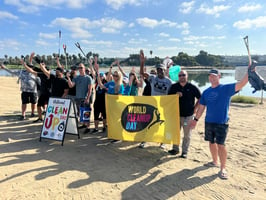Harnessing the Power of AI to Elevate Volunteer and Donor Engagement
In the ever-evolving landscape of nonprofit organizations, fostering relationships with both volunteers and donors is crucial for sustained success.
In a recent discussion featuring insights from Kelly Cristaldi and John Mark Vanderpool, the conversation centered around innovative strategies for enhancing these relationships, particularly through the use of Artificial Intelligence (AI).
This blog post explores the key takeaways from their conversation, providing actionable insights for nonprofit leaders looking to maximize engagement and ultimately drive impact.
Check out the recording to see their conversation or keep reading for the highlights!
Community Connection and Emotional Engagement
A central theme throughout the conversation was the emotional aspect of giving and volunteering. People are not just looking for ways to donate money or time; they seek meaningful experiences that make their lives matter. Nonprofits have the unique opportunity to serve as conduits for this desire for impact and purpose.
By fostering a community-oriented culture, organizations can create a sense of belonging among volunteers and donors. This connection is vital for retaining support and encouraging deeper involvement with your cause.
A Long-Term Engagement Strategy
John Mark pointed out that engaging volunteers is not just a short-term tactic; it’s a long-term strategy for donor acquisition and retention. When organizations effectively cultivate a robust volunteer program, they lay the groundwork for converting these volunteers into donors.
Consider the implications of expanding your volunteer base. John Mark posed a thought-provoking question: What if your organization could increase its volunteer numbers from 100 to 1,000 in a year?
This ambitious goal might seem daunting, but the potential for growth in donor engagement is tremendous. Volunteers who are invested in your mission are statistically more likely to contribute financially as well.
Embracing for "The Gray Wave"

With the rise of retirees in the United States, now is a prime time to begin recruiting them for your volunteer programs. This demographic is keen to spend their golden years contributing back to their community. Make sure that you make the process simple, easy, and rewarding for them!
"We're seeing 4.1 million people retiring every year in the United States. It's astounding just to think about the volume of people that are retired and this is a good thing, right?," says John Mark. "This is this is a wonderful opportunity for nonprofits. We have all of these people that are retiring that are looking to get involved. Consider how your organization can tap into this demographic of volunteers because they're here and we've never had this many before."
AI as Your Strategic Co-Pilot
John Mark introduced a compelling analogy, likening AI tools to co-pilots in the journey of nonprofit management. He articulated how these tools can assist in content creation, data analysis, and even strategic planning. For instance, platforms like ChatGPT can help nonprofits craft engaging newsletters, articulate impactful fundraising appeals, and refine messaging.
However, it's essential to approach AI as a partner rather than a replacement for human creativity. Vanderpool encouraged organizations to think of AI as a brainstorming tool. When developing a newsletter or an appeal letter, you might prompt the AI to generate ideas or even draft initial content, allowing you to refine and personalize it. This collaborative approach not only saves time but also enhances the quality of your messaging.
Data Security Considerations
While the benefits of AI are significant, it’s crucial to tread carefully, particularly when handling sensitive donor information. Kelly emphasized the importance of maintaining data privacy, advising against uploading any proprietary or sensitive information into AI platforms.
Instead, organizations can leverage AI for tasks that do not involve sensitive data. For example, AI can assist in generating reports based on aggregated data without compromising individual donor information. Organizations must remain vigilant about data security, ensuring that they utilize AI tools responsibly and ethically.
Kelly expounds upon this by noting, "There's a lot of security measures but I'm suggesting is to not go to ChatGPT and upload an Excel file with like a thousand rows of information about your donors. It's just a bad time, but for all of these other purposes I think it's great. I think it's really wonderful to leverage some of these other AI tools that will offload things from your plate and allow you to get back to the meat of your work."
The Importance of Gratitude in Engagement

One of the core themes discussed was the significant role that gratitude plays in nurturing relationships with top donors and volunteers. Kelly emphasized that personal interactions, such as thank-you calls to recent donors, can substantially enhance community spirit and individual connections.
Imagine a scenario where your organization makes it a standard practice to have staff or board members reach out to top supporters, expressing heartfelt thanks for their contributions. Not only does this make the supporters feel valued, but it also strengthens the bond between them and your organization. As Kelly pointed out, hearing a genuine "thank you" can brighten someone's day and encourage them to stay engaged with your mission.
Case Study: California Climate Action Corps
To illustrate the transformative power of volunteer engagement, Cristaldi shared the success story of the California Climate Action Corps, which managed to engage an impressive 23,000 volunteers annually. This achievement was made possible through effective volunteer management and the strategic use of technology.
The case study serves as a testament to what is achievable when organizations prioritize volunteer engagement. Imagine the impact if your nonprofit could replicate this success. If even a small percentage of those volunteers became donors, the potential for fundraising success is remarkable. Organizations should take note of successful models like this and consider implementing similar strategies tailored to their unique missions.
Practical Steps for Implementation
Here are several actionable strategies for nonprofits to enhance volunteer and donor engagement using the insights from the discussion:
- Establish a Gratitude Program: Develop a systematic approach to recognizing and thanking donors and volunteers. This could include personalized thank-you calls, handwritten notes, or recognition events.
- Leverage AI Tools: Use AI platforms like ChatGPT for brainstorming content ideas, drafting communications, and analyzing data trends. Treat AI as a collaborative partner in your strategic planning.
- Focus on Data Security: Ensure that any use of AI aligns with best practices for data protection. Avoid uploading sensitive donor information and utilize AI for tasks involving aggregate data instead.
- Expand Volunteer Programs: Set ambitious goals for volunteer recruitment. Create a comprehensive volunteer strategy that emphasizes engagement and retention, understanding that volunteers can become future donors.
- Learn from Success Stories: Research case studies from organizations that have successfully scaled their volunteer programs. Implement best practices and tailor them to your organization’s needs.
As the nonprofit sector continues to evolve, embracing innovative strategies like AI for engagement can significantly enhance the effectiveness of volunteer and donor relationships. By prioritizing gratitude, leveraging technology, ensuring data security, and focusing on long-term engagement strategies, nonprofits can cultivate a thriving community of supporters.
As you consider these insights, remember that the ultimate goal is to connect people to meaningful experiences and empower them to make a difference. In doing so, you can transform volunteers into advocates and donors into lifelong supporters of your cause.




